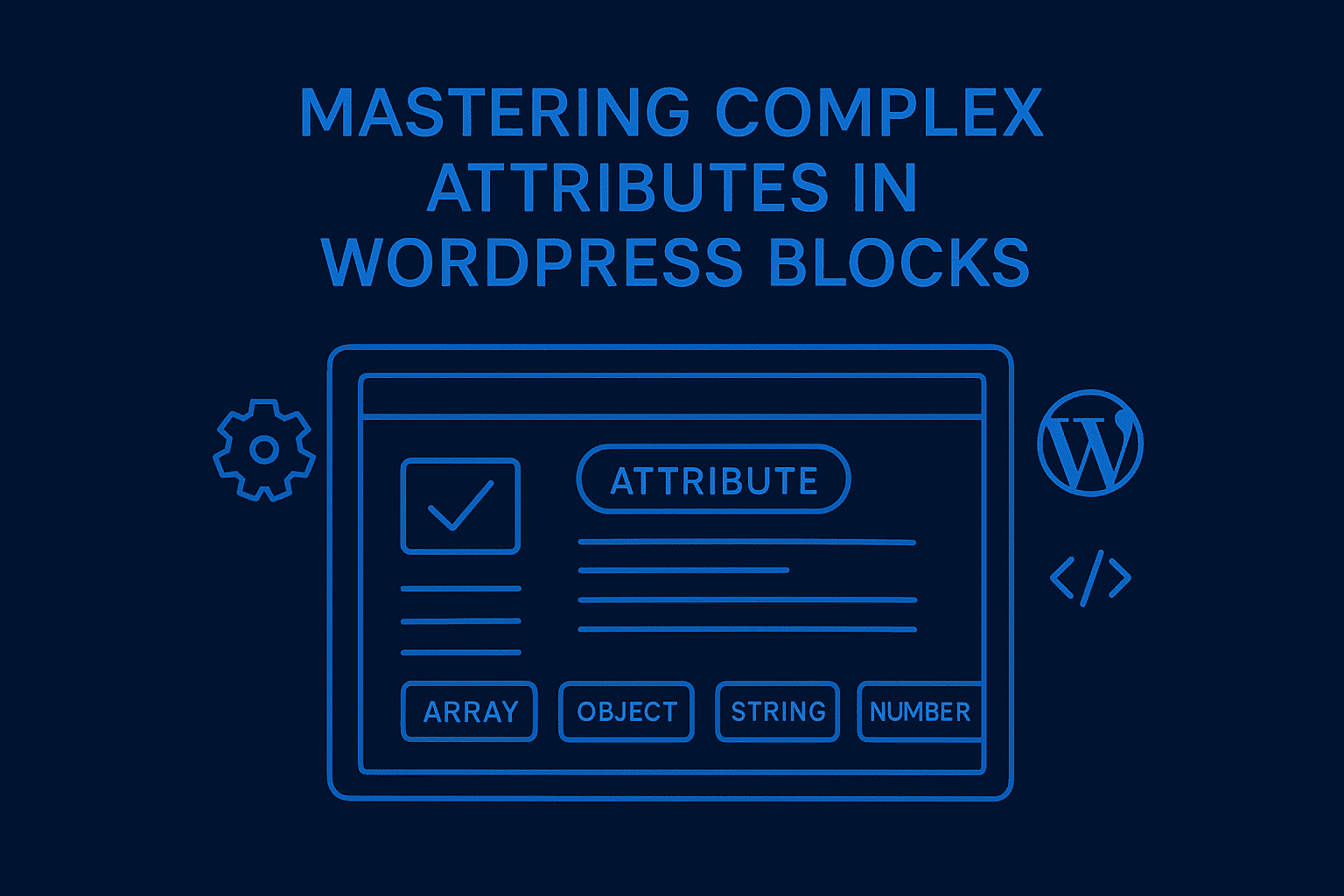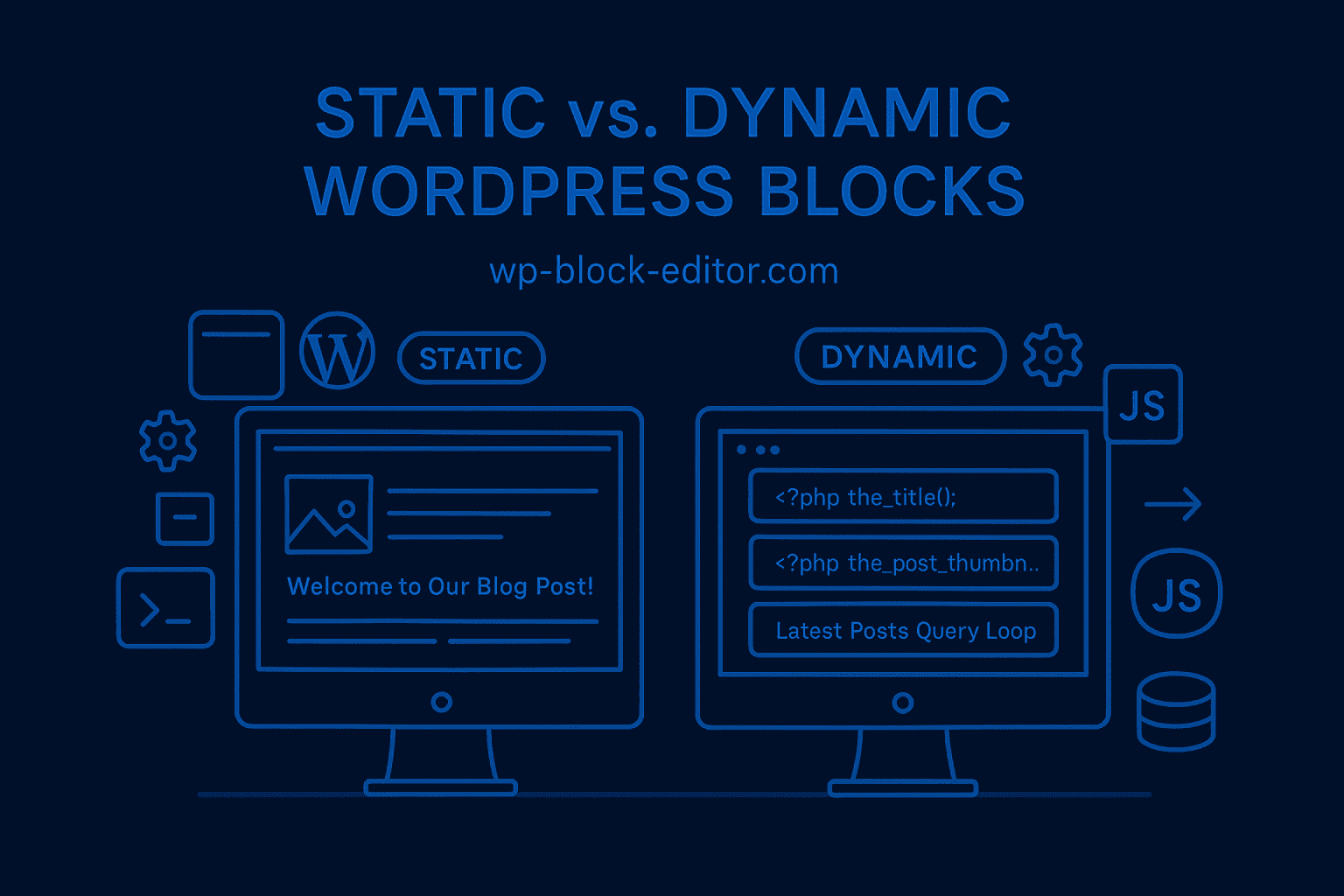Block attributes form the foundation of dynamic WordPress blocks, but most developers only scratch the surface of what’s possible. Moving beyond simple string and boolean attributes to complex data structures opens up sophisticated functionality while maintaining the intuitive editing experience users expect.
Beyond Basic Attributes
Simple attributes work well for basic customization—colors, text strings or toggle switches. But complex blocks often need structured data: lists of items, nested configurations, or relationships between multiple elements. WordPress supports rich attribute types that can handle these scenarios elegantly.
The key is understanding how WordPress serializes and deserializes complex data structures. Arrays and objects stored as attributes must survive the save-and-reload cycle while remaining editable through the block inspector and other interfaces.
Working with Array Attributes
Array attributes excel for repeatable content like galleries, feature lists, or testimonial collections. They provide dynamic functionality where users can add, remove, and reorder items without rebuilding the entire block structure.
// Block registration with array attribute
wp.blocks.registerBlockType('mytheme/feature-list', {
attributes: {
features: {
type: 'array',
default: [],
items: {
type: 'object',
properties: {
title: { type: 'string' },
description: { type: 'string' },
icon: { type: 'string' },
highlight: { type: 'boolean', default: false }
}
}
}
}
});
// Managing array data in the edit component
function Edit({ attributes, setAttributes }) {
const { features } = attributes;
const addFeature = () => {
const newFeatures = [...features, {
title: '',
description: '',
icon: '',
highlight: false
}];
setAttributes({ features: newFeatures });
};
const updateFeature = (index, key, value) => {
const updatedFeatures = features.map((feature, i) =>
i === index ? { ...feature, [key]: value } : feature
);
setAttributes({ features: updatedFeatures });
};
}
Code language: JavaScript (javascript)Object Attribute Strategies
Object attributes work well for grouped settings or complex configurations. They keep related data together while allowing granular updates to individual properties. This approach is particularly useful for styling objects, API configurations, or multi-step form data.
// Block registration with nested object
wp.blocks.registerBlockType('mytheme/hero', {
attributes: {
heroConfig: {
type: 'object',
default: {
layout: 'split',
textAlign: 'left',
style: {
bgColor: '#ffffff',
overlay: false
}
}
}
}
});
// Edit component handling nested updates
const Edit = ({ attributes, setAttributes }) => {
const updateStyle = (key, value) => {
setAttributes({
heroConfig: {
...attributes.heroConfig,
style: {
...attributes.heroConfig.style,
[key]: value
}
}
});
};
return (
<PanelBody title="Style Settings">
<ToggleControl
label="Overlay"
checked={attributes.heroConfig.style.overlay}
onChange={(val) => updateStyle('overlay', val)}
/>
<ColorPicker
color={attributes.heroConfig.style.bgColor}
onChange={(val) => updateStyle('bgColor', val)}
/>
</PanelBody>
);
};
Code language: JavaScript (javascript)When designing object attributes, consider the user interface implications. Nested objects can become difficult to manage in the block inspector. Sometimes flattening the structure with prefixed attribute names provides a better editing experience.
Managing Complex State
Complex attributes require careful state management to avoid performance issues and maintain data integrity. Immutable update patterns prevent reference issues that can cause React rendering problems or data corruption.
Always use functional updates when modifying array or object attributes. This ensures WordPress properly detects changes and triggers saves, while preventing subtle bugs related to object reference equality.
// Immutable update for nested array
const updateTestimonialRating = (index, newRating) => {
setAttributes({
testimonials: attributes.testimonials.map((item, i) =>
i === index ? { ...item, rating: newRating } : item
)
});
};
// Adding new entry with fallbacks
const addTestimonial = () => {
setAttributes({
testimonials: [
...attributes.testimonials,
{
name: '',
quote: '',
rating: 3,
meta: {}
}
]
});
};
Code language: JavaScript (javascript)Validation and Schema Design
Complex attributes benefit from explicit validation to prevent malformed data. WordPress’s block validation system can catch structure mismatches, but implementing additional client-side validation improves the user experience and prevents errors.
// Client-side validation before save
const isValidData = attributes.teamMembers.every(member =>
member.name && /^https?:\/\//.test(member.avatar)
);
// Schema with future-proof defaults
attributes: {
teamMembers: {
type: 'array',
default: [{
name: '',
role: '',
avatar: '',
socialLinks: [] // New property added in v2
}],
items: { type: 'object' }
}
}
// Edit component fallback
const member = {
socialLinks: [],
...currentMember
};
Code language: JavaScript (javascript)Design schemas that can evolve. Consider how new properties might be added to objects or how array item structures might change in future versions. Provide sensible defaults for missing properties to maintain backward compatibility.
Performance Considerations
Complex attributes can impact editor performance, especially with large arrays or deeply nested objects. Implement lazy loading for expensive operations and consider debouncing user input updates to reduce unnecessary re-renders.
// Debounced attribute updates
import { useDebounce } from '@wordpress/compose';
const EditComponent = ({ attributes, setAttributes }) => {
const [localText, setLocalText] = useState(attributes.longContent);
const updateHandler = useDebounce(() => {
setAttributes({ longContent: localText });
}, 500);
return (
<TextareaControl
value={localText}
onChange={(text) => {
setLocalText(text);
updateHandler();
}}
/>
);
};
// Lazy loading heavy data
const fetchExternalData = () => {
if (attributes.showDetails) {
// Load only when expanded
}
};
Code language: JavaScript (javascript)Be mindful of serialization overhead. Massive or complex attribute structures can bloat post content and impact loading times. Sometimes storing complex data in post meta or custom tables provides better performance than block attributes.
Real-World Applications
Complex attributes shine in scenarios like product configurators, event listings, team member directories, or any block that manages multiple related data points. They enable sophisticated functionality while maintaining the familiar WordPress editing experience.
Consider a testimonial slider block that stores an array of testimonial objects, each containing name, quote, photo, and rating data. This structure supports dynamic content management while providing rich editing capabilities.
// Testimonial slider implementation
registerBlockType('mytheme/testimonial-slider', {
attributes: {
testimonials: {
type: 'array',
default: [],
items: {
type: 'object',
properties: {
name: { type: 'string' },
quote: { type: 'string' },
rating: { type: 'number', default: 5 },
photo: { type: 'string' }
}
}
},
transitionSpeed: {
type: 'number',
default: 300
}
},
edit: EditComponent,
save: SaveComponent
});
Code language: PHP (php)Debugging Complex Attributes
Debugging complex attribute issues requires understanding WordPress’s serialization process. Use browser developer tools to inspect attribute values, and implement logging to track how data flows through your block’s lifecycle.
// Console inspection
console.log('Current attributes:', attributes);
// Using WordPress data module
const { select } = wp.data;
console.log(
'Block attributes:',
select('core/block-editor').getBlockAttributes(clientId)
);
// Validation error handling
try {
JSON.parse(attributes.complexData);
} catch (e) {
console.error('Invalid JSON structure:', e);
}
Code language: JavaScript (javascript)The WordPress data module’s select and dispatch functions provide powerful debugging capabilities for understanding how attribute changes propagate through the editor state.




